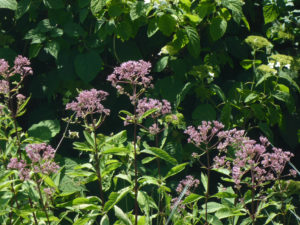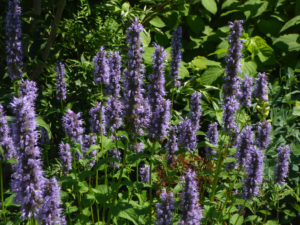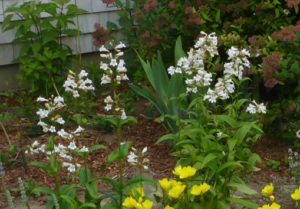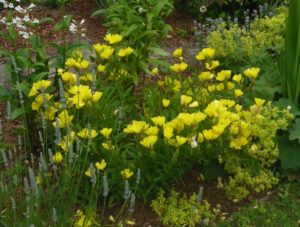By Cathy Weston
Back in my professional working days, I relished the quiet time around the holidays. I had used up my vacation days doing fun stuff, so I went into the office and used the time to clean out and organize files, make a priority list of the next year’s goals, and start my year-end review.
Now, as an ecological gardener, I do something similar. The garden beds are as cleaned out and organized as I do in the fall, I am working on my list of next year’s planting projects, and I am taking stock of how the journey to ecological gardening is going.
The journey is one of both continuous learning and applying what I learn. I’ve been taking lots of webinars (thank you, ELA!) and doing some reading on my own. This winter, I’ll be working on applying what I have learned in my own landscape, evaluating specific garden beds and making plans for next year. But for now, I want to step back and reflect on the major things I have learned this year.
Which Sunny Pollinator Plants Are Reliable in My Garden
Every garden space has different characteristics, and plants that, in theory, ought to work in your space may thrive – or not. I have two sunny pollinator spaces, one facing southeast in a sheltered spot behind the house and the other in a more exposed and windy space facing southwest. Both have sandy acidic soils, but the sheltered spot has richer soil after years of amendments.
It has been interesting to see how various plants have done in these conditions, especially to determine if they are reliable. By this, I mean that they are long-lived, at least three years, and are not enjoyed by the rabbits that abound in this neighborhood. Between the two beds, I’ve learned that these 12 plants are reliable for me.
Barren strawberry (Geum fragarioides)
Blue star (Amsonia tabernaemontana cultivar)
Joe-Pye weed (Eupatorium fistulosum)
Narrow-leaf mountain mint (Pycnanthemum tenuifolium)
Mad dog skullcap (Scutellaria lateriflora)
Anise hyssop (Agastache foeniculum ‘Blue Fortune’)
Broad-leaf mountain mint (Pycnanthemum multicultural)
Boneset (Eupatorium perfoliatum)
Spotter bee balm (Monarda punctata)
Beardtongue (Penstemon digitalis)
Sun drops (Oenothera fruticosa cultivar)
Goldenrod (Solidago species)
- Joe-Pye Weed (Eutrochium fistulosum)
- Anise hyssop (Agastache foeniculum ‘Blue Fortune’)
- Beardtongue (Penstemon digitalis and P. “Dark Towers”)
- Sundrops (Oenothera fruticosa cultivar)
All of these are US natives, and most are native to Cape Cod. Most are hardy perennials, but a few self-seed reliably in my garden. This list will be my core sunny plant palette going forward, and I will keep looking for more, especially plants that flower early in the season and some that have red or orange blooms.
What’s also interesting is what didn’t make the list – swamp milkweed, butterfly weed, false indigo, black-eyed Susan, echinacea – all plants often seen in native plant gardens. In mine, it was mostly the rabbits that did these plants in. If I want to plant them, I use pots to get them out of rabbit-reach.
Designing for Texture and Shape in the Shade
As an ornamental gardener, I am mesmerized by color. My garden designs aspired to lovely combinations in a continuous sequence throughout the season (occasionally achieved). And when I visit another garden, the bright pops of color are what I look for first.
But in native plants for shady situations, the color is much less important a trait – more like an ephemeral bonus than a major highlight. It’s really the plant’s shape and its texture that are key to a season-long pleasing design. But coming up with such a design has, for me, been a challenge.
The primary experiment has been my woodland garden area, and three years later, I can see the design is working. It’s a lovely low tapestry of different shade plants – black huckleberry, white woodland aster, baneberry, lady fern, goatsbeard, and columbine form a low herbaceous layer over wild strawberry and hairgrass, which serve as ground covers. I love the semi-controlled messiness within a well-defined bed under the trunks of wild cherry trees.
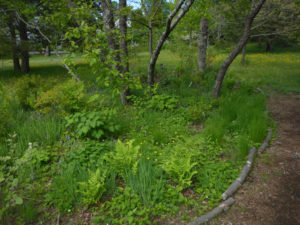
In the new front corner garden, I’m using many of the same plants and trying a different arrangement. The design goal is to see how the textures might make a pattern that is more orderly and can deliberately draw the eye around the space. This involves larger clumps and intertwined drifts of different textures circling around under an oakleaf hydrangea. More to come on this project!
Some New-to-Me Plants
I figure I have dozens of different species of native plants (a good winter project: count them). But there are probably at least a hundred different species I could try, so I have lots of room to learn about new-to-me native plants that should grow in my landscape. Here are the ones I’ve tried over the last year or so.
Planted in sunny beds:
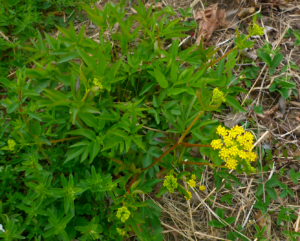
Golden alexander (Zizia aurea)
This plant is 1-1.5 feet high and blooms with these bright yellow umbels in June. It’s listed as one of the earliest blooming pollinator plants.
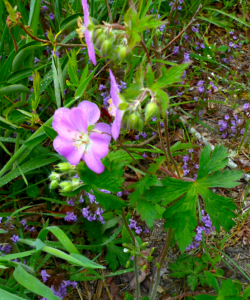
Wild geranium (Geranium maculatum)
Almost all of the hardy geraniums in the nursery are non-native. This one, though, is native to eastern North America. The leaves are large, it has a lovely pinkish bloom, and should spread fairly easily.
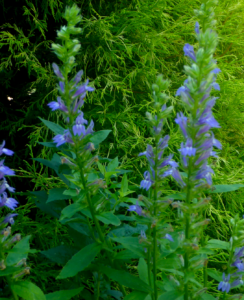
Blue cardinal flower (Lobelia siphilitica)
We all know the red cardinal flower, but I didn’t know about the blue variety until someone gave me a plant. They bloom in late summer with these beautiful blue spikes.
Plants in shady places:
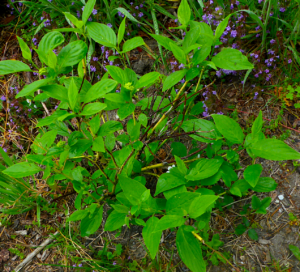
American spikenard (Aralia racemosa)
I’m still not sure about this plant. The foliage is a nice green, and it has white flowers in mid-summer, but it doesn’t look like it is really thriving. So it’s wait and see time.
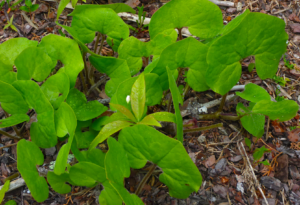
Wild ginger (Asarum canadensis)
This is similar to the glossy-green ginger that is common in the nurseries, but it isn’t glossy. It will form a nice clump over time.
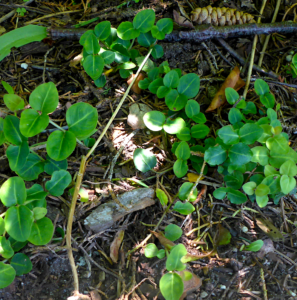
Partridge berry (Mitchella repens)
This is a very low-growing ground cover that I have planted at the very edge of the shady bed underneath some black cohosh. It hasn’t bloomed yet, but the flowers are joined, like the leaves, and the red berry has two spots for the two joined flowers.
Shrubs and a small tree:
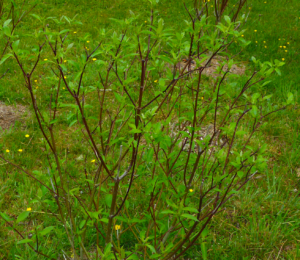
Silky dogwood (Cornus amomum)
Three of these planted in a clump will eventually grow to be a large mound shape, close to 6 feet tall. They have white flowers, not very showy, and lovely purple berries in the fall.
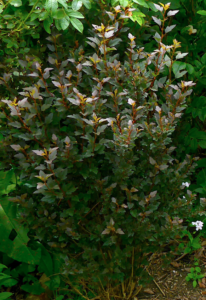
Ninebark (Physocarpus opulifolius ‘Tiny Wine’)
I know purple foliage is absolutely not native, but I wanted an accent in front of some rosa rugosa. This dwarf version survived the drought last summer with very little supplemental watering in only its second year
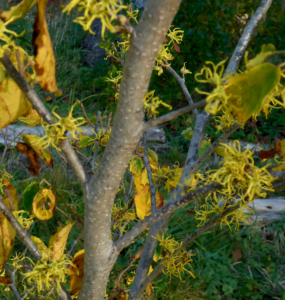
Witch hazel (Hamamelis virginiana)
There are only two witch hazels native to the US, and this one blooms with these showy yellow thread-like flowers, just as the leaves are starting to fall.
Each of these plants, while still young, has done well through one growing season or was planted last fall and survived the winter and returned this year. Let’s hope they make it to the “reliable” list in the future!
Pollinator Life Cycles and How That Impacts Gardening Practices
I’m not interested in insects, but if I mean to support wildlife, I should know at least the basics of what pollinators need. So this year, I took a couple of webinars, read a book, observed in the garden, and learned some interesting facts that will affect my gardening going forward:
Most pollinators want to feed on just one kind of flower at a time, and they want to get as much in one “stop” as possible, rather than flying all over the garden. This is a strong case for planting your pollinator-attracting plants in large clumps rather than individual plants or a thin drift.
There are dozens of species of native bees, wasps, beetles, and other flying creatures in Cape Cod, Massachusetts. Most are solitary and nest in small individual burrows in the ground, not in hives. They prefer bare sandy soil, or under leaf litter, or at the base of a pile of old wood. This means they welcome messy areas in the yard all year round, so it is good to leave a corner or an out of the way place for them to nest.
Each adult only lives for a few weeks each year. Then they create a burrow, provide it with food for their offspring, and lay their eggs. The eggs become larvae and pupae over the course of the year, and the new adults emerge around the same time as their mother did last year. So while we see bees all spring, summer, and fall, they are different types who eat different foods. This means it’s important to have flowering plants for different types of pollinators all season long.
How Climate Change Impacts My Landscape and What I Can Do About It
Climate change is a big problem that needs big solutions, and I support organizations that are raising awareness and lobbying for these solutions. Still, I wanted to understand how climate change impacts my particular landscape and what I can do personally to help. This summer, I was invited to speak at the Chatham Climate Impact webinar, and from the other talented speakers, I learned a lot. I’ve boiled their many useful points down into just a few major things that I can work with.
The first big impact will be more frequent storms with the associated stormwater runoff. Runoff from non-permeable surfaces, such as roofs, driveways, and streets, is contaminated, and increased runoff means increased pollution in our neighborhood wetlands, embayments, and groundwater. To combat this, I can strive to keep all runoff on my own property, primarily with planting beds that capture the runoff and allow it to be cleansed as it seeps down through the roots into the ground. Also, I can reduce the non-permeable surfaces on my property and direct runoff away from the street into the landscape.
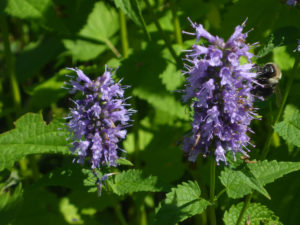
The second big impact is the heat and droughts that stress plants. Instead of being an occasional issue, heat and drought are likely to occur more years than not, so the landscape needs to be adapted. Native plants that survived this summer without supplemental water, like bayberries and sweet fern, can be planted in larger numbers. I can add more trees for more shade to help the understory better survive. I can plan for more efficiency in supplemental watering by grouping plants together so I only water in a limited region. And I have already abandoned watering the lawn.
I also learned that my own gardening practices could help. I can reduce the use of gas-powered garden tools, for one. And every landscape, even my single home property, can help sequester more carbon by growing more plants (yay!) and minimizing soil disturbance. Trees, shrubs, deep-rooted grasses, perennials – they all help.
About the Author
After a business career and a lifetime of traditional gardening, Cathy Weston embarked on a journey to become a garden ecologist and native-plant landscape designer. She completed a Certificate in Native Plant Horticulture and Design from the New England Wild Flower Society. She writes a blog www.goldenrodgarden.com about using native plants in her Cape Cod garden.
Besides her own gardening, she volunteers with the horticulture staff at the Rose Kennedy Greenway Conservancy in Boston as a regular zone gardener and as a horticultural writer. She is a Trustee at the Chatham Conservation Foundation, the land trust serving Chatham MA, and serves on the Board of the Friends of Sylvan Gardens, a conservation area in Chatham, MA.
***
Each author appearing herein retains original copyright. Right to reproduce or disseminate all material herein, including to Columbia University Library’s CAUSEWAY Project, is otherwise reserved by ELA. Please contact ELA for permission to reprint.
Mention of products is not intended to constitute endorsement. Opinions expressed in this newsletter article do not necessarily represent those of ELA’s directors, staff, or members.

